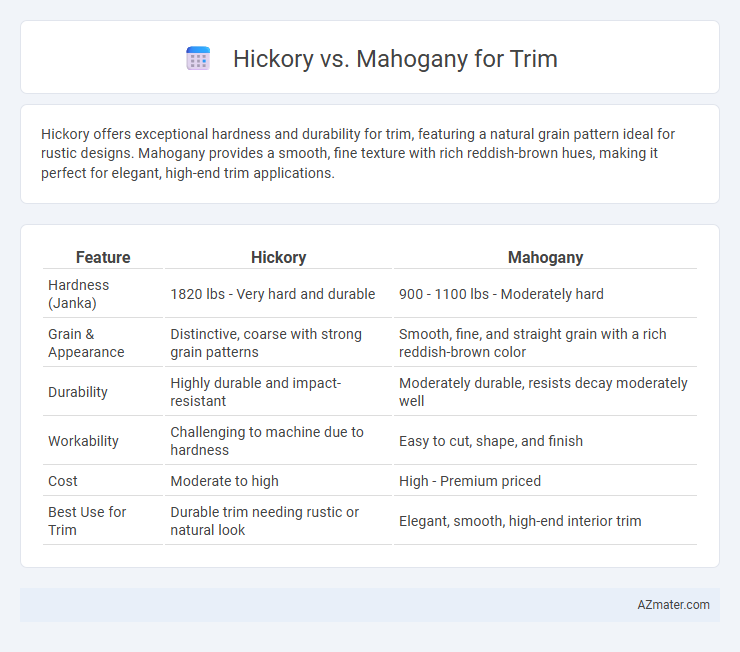Hickory offers exceptional hardness and durability for trim, featuring a natural grain pattern ideal for rustic designs. Mahogany provides a smooth, fine texture with rich reddish-brown hues, making it perfect for elegant, high-end trim applications.
Table of Comparison
| Feature | Hickory | Mahogany |
|---|---|---|
| Hardness (Janka) | 1820 lbs - Very hard and durable | 900 - 1100 lbs - Moderately hard |
| Grain & Appearance | Distinctive, coarse with strong grain patterns | Smooth, fine, and straight grain with a rich reddish-brown color |
| Durability | Highly durable and impact-resistant | Moderately durable, resists decay moderately well |
| Workability | Challenging to machine due to hardness | Easy to cut, shape, and finish |
| Cost | Moderate to high | High - Premium priced |
| Best Use for Trim | Durable trim needing rustic or natural look | Elegant, smooth, high-end interior trim |
Introduction to Hickory vs Mahogany for Trim
Hickory and mahogany are popular hardwood choices for trim due to their distinct grain patterns and durability. Hickory offers a tougher, denser texture with a rustic, varied grain, making it ideal for high-traffic areas requiring strong resistance to wear. Mahogany, prized for its rich reddish-brown hue and smooth, consistent grain, provides an elegant and classic finish that enhances upscale interior designs.
Wood Characteristics: Hickory vs Mahogany
Hickory wood is prized for its exceptional hardness, strength, and shock resistance, making it ideal for trim that demands durability and wear resistance. Mahogany, on the other hand, offers a smoother grain, rich reddish-brown color, and natural pest resistance, providing a luxurious and elegant appearance for interior trim. Both woods excel in workability, but Hickory's dense texture contrasts with Mahogany's fine, even grain, influencing staining and finishing outcomes.
Appearance and Grain Comparison
Hickory trim features a bold, contrasting grain pattern with a mix of light and dark streaks, creating a rustic and dynamic visual appeal. Mahogany trim offers a smooth, fine-grain texture with a consistent reddish-brown hue, providing a classic and elegant look. The distinct grain complexity of hickory contrasts sharply with mahogany's uniformity, making hickory ideal for bold, natural aesthetics and mahogany perfect for refined, traditional designs.
Durability and Hardness Factors
Hickory offers exceptional durability and hardness, ranking around 1,820 on the Janka hardness scale, making it highly resistant to dents and wear for trim applications. Mahogany, while slightly less hard with a Janka rating near 800 to 900, provides excellent stability and consistency in grain, contributing to long-lasting elegant trim. Choosing hickory ensures maximum resilience in high-traffic areas, whereas mahogany delivers balanced hardness with superior aesthetic appeal for refined interior trim.
Color and Finish Options
Hickory offers a broad spectrum of natural colors ranging from creamy whites to rich browns with pronounced grain patterns that create a rustic appearance, ideal for warm, textured trim finishes. Mahogany provides a deeper, reddish-brown hue with a smooth, fine grain that enhances elegant and polished trim designs, often showcasing a luxurious, satin finish. Both woods accept stains well, but mahogany's consistent color and smoother texture allow for a more uniform finish, while hickory's varied grain and color make each trim piece uniquely distinct.
Workability and Ease of Installation
Hickory offers exceptional workability due to its density and strength, making it ideal for trim that requires precise cuts and durability, though it may demand sharper tools and more effort to install. Mahogany, known for its smooth grain and softer texture, provides easier cutting and shaping, facilitating faster installation with less tool wear. Both woods deliver high-quality finishes, but Hickory's toughness can challenge ease of installation compared to the more pliable mahogany.
Maintenance and Longevity
Hickory offers exceptional durability and requires minimal maintenance, making it ideal for high-traffic trim areas due to its natural resistance to dents and scratches. Mahogany, prized for its rich color and smooth grain, demands more careful maintenance, including regular sealing and polishing to preserve its appearance and prevent moisture damage. While mahogany provides a luxurious finish, hickory's superior hardness ensures longer-lasting trim with less upkeep over time.
Cost Differences: Hickory vs Mahogany Trim
Hickory trim typically costs between $6 to $15 per board foot, making it a more affordable option compared to mahogany, which ranges from $20 to $35 per board foot. The price difference is influenced by mahogany's exotic status, durability, and rich reddish-brown hue, which adds higher value to interior design projects. Homeowners seeking budget-friendly wood with strong durability often prefer hickory for trim, while those investing in luxury finishes may opt for the premium appeal of mahogany.
Best Applications for Each Wood Type
Hickory is ideal for trim in high-traffic or rustic settings due to its exceptional hardness, durability, and striking grain patterns, making it perfect for farmhouse or cabin-style interiors. Mahogany's rich, reddish-brown color and fine, straight grain lend elegance to traditional, formal spaces, where it excels in detailed molding, wainscoting, and luxury trim work. Both woods offer unique benefits: hickory for robust, casual applications and mahogany for refined, upscale finishes.
Choosing the Right Wood for Your Space
Hickory offers exceptional durability and distinctive grain patterns, making it ideal for high-traffic areas or rustic interior designs, while mahogany provides a rich, deep reddish-brown color and smooth texture suited for elegant, traditional spaces. Consider the specific environmental conditions and aesthetic goals of your space; hickory withstands wear and tear better in busy households, whereas mahogany's natural resistance to moisture makes it perfect for humid environments. Selecting the right wood trim hinges on balancing hardness, grain character, and color tone to complement your interior style and maintain long-term performance.

Infographic: Hickory vs Mahogany for Trim
 azmater.com
azmater.com